When you have to go at Sharon Hanson’s house, you’ll sit face-to-face with Rosie the Riveter.
Hanson, 78, of Monroe, has a mannequin dressed like the working women’s icon of the World War II era in her bathroom. Rosie, clad in overalls and a bandana, is seated on the bathtub.
Rosie the Riveter starred in a campaign aimed at recruiting American women for wartime factory jobs, taking over for men drafted into the military. The campaign worked: Women entered the workforce in unprecedented numbers. Many of them got jobs in the U.S. aircraft industry.
Hanson’s Rosie is made to look just like artist Norman Rockwell’s “Rosie the Riveter.” His cover for the May 29, 1943, edition of The Saturday Evening Post portrays a brawny Rosie taking her lunch break, a ham sandwich in one hand and a rivet gun in her lap.
“They are invisible veterans of the war,” Hanson said, of the hundreds of thousands of women who went to work.
Hanson’s bathroom was inspired by a plate. Hanson loves the Norman Rockwell’s collector’s plate featuring his “Rosie the Riveter” cover.
“When I remodeled my house, I wanted a themed bathroom,” Hanson said. “I like the ‘Rosie the Riveter’ cover. It’s my mantra. For everything I do in my life, I just say ‘I can do it.’ It’s helped me through so much in my life, just that, saying it over and over that I can do it.”
Hanson gets her mantra from another Rosie — the one created in 1942 by artist J. Howard Miller, and featured on a poster for Westinghouse Electric Corp. with the headline “We Can Do It!” His poster is often mistakenly called “Rosie the Riveter” — Miller’s worker was never referred to as “Rosie” during the war — and today is regarded as an icon of American feminism.
In 1943, a song hit the radio called “Rosie the Riveter,” and the name went down in history.
Hanson’s Rosie even has all of the pins shown on Rosie the Riveter’s overalls, as Christmas gifts from her son Dennis Hanson.
He found exact replicas of Rosie’s pins via eBay, purchasing them one by one. According to his research, she wears a Red Cross Donor button, a Blue Star Service Flag pin, a V for Victory button, two Pro Partia Blood Donor pins and an Army/Navy Production Award pin. The only thing her son couldn’t get is a replica of Rosie’s identity badge.
“I think that’s such a cool gift,” Sharon Hanson said. “One of my favorite things in the whole world is that I have those.”
Her son also gifted her something else pictured in the “Rosie the Riveter” cover: a copy of Hitler’s “Mein Kampf.” His mother asked for it. Dennis Hanson said Rockwell included the evil tome in the painting to make a point. Rosie has her foot on top of the book, metaphorically stomping on Hitler’s beliefs.
“I’m probably the only one who has actually purchased a copy of ‘Mein Kampf’ on eBay to put in my mother’s bathroom,” said Dennis Hanson, 59. “So it’s there and that’s what it’s for, and if somebody wants to judge, well, OK.”
Why does her Rosie the Riveter mannequin reside in the bathroom? Hanson had her in the living room, but it scared her house guests. When she cleans the bathtub, however, she very carefully moves Rosie to the couch.
“(You) can use this bathroom, but it’s basically a museum,” Hanson said, who got a tattoo of Miller’s Rosie the Riveter on her left bicep in 2007.
Her collection includes: A teddy bear clad in overalls that features the Postal Service’s Rosie the Riveter stamp from 1999. A Rosie the Riveter quilt handmade by her neighbors. A framed cover of the sheet music for the “Rosie the Riveter” song written by Redd Evans and John Jacob Loeb. A Rosie Christmas ornament. A Rosie-themed swimsuit cover-up that Hanson’s worn to the beach. And a Rosie the Riveter lunchbox from Archie McPhee.
The lunchbox serves as a sort of Rosie the Riveter scrapbook: Over the years, Hanson has collected magazine and newspaper clippings that mention the World War II icon and the women who inspired her likeness. Many of them are stories that ran in The Daily Herald.
“I think that for a lot of women, it’s a reminder that ‘I can do it,” Hanson said. “That’s what it means. It just gives me so much (strength).”
Also in the bathroom is a pin board that shows off campaign buttons from across the political spectrum in which Rosie the Riveter was a star: Hillary Clinton, John Kerry, Sarah Palin, Bernie Sanders, Women for Obama, etc.
Her late husband, Clinton Hanson, was a retired U.S. Army sergeant who served with the 11th Airborne during World War II. He died in 2006 at 82. His awards and decorations, as well as his burial flag, are enshrined in Hanson’s bathroom.
Together they raised three children and were the original owners of the Duvall Market in Duvall. In 1975, they moved to Monroe.
In actuality, Hanson’s Norman Rockwell collection spans most of the house, and includes close to 70 plates featuring the illustrator’s most popular Saturday Evening Post covers. He illustrated the magazine for nearly five decades. There were 323 Rockwell covers from 1916 to 1963.
“One of the things I love about Rockwell: His pictures tell a story,” Hanson said. “Every one.”
Of course, the story she loves the most is Rosie the Riveter’s.
Here’s how her son Dennis explained his mother’s collections: She’s into Norman Rockwell, and she also is into Rosie the Riveter, and in her bathroom is where those two loves intersect.
During hard times, “she needed to have faith in herself that she could do it,” he said. Rosie’s mantra helped her to remember that.
“She did it.”
Sara Bruestle: 425-339-3046; sbruestle@heraldnet.com; @sarabruestle.
Your room could be next
This story is part of an occasional series on themed rooms. Do you have a Greta Garbo bedroom? A living room that maps your world travels? A Seahawks or Sounders man cave? We want to feature your special room in the Homes section. Email features@heraldnet.com.
Talk to us
> Give us your news tips.
> Send us a letter to the editor.
> More Herald contact information.



























